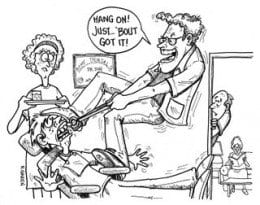The Truth About Tooth Extraction
May 20, 2013 | News | The Office of The Palisades Dentists
For many patients, the idea of tooth extraction conjures up images of intense pain and a lengthy  recovery, but advances in dentistry have made this procedure much less painful and complicated than in years past. Your dentist may have to extract a tooth if it is severely decayed, if it is not “coming in” properly, or, in the case of young patients, in preparation for orthodontics. Some extractions take place in the dentist’s office, and some patients need to visit an oral surgeon for a tooth extraction.
recovery, but advances in dentistry have made this procedure much less painful and complicated than in years past. Your dentist may have to extract a tooth if it is severely decayed, if it is not “coming in” properly, or, in the case of young patients, in preparation for orthodontics. Some extractions take place in the dentist’s office, and some patients need to visit an oral surgeon for a tooth extraction.
One common reason for a tooth extraction is the removal of third molars, or wisdom teeth. If the teeth have erupted, or “come in,” then the procedure is no more difficult than the removal of any other tooth. If the teeth are impacted (still under the gum), your dentist will refer you to an oral surgeon for their extraction. This process is usually performed by the oral surgeon’s making an incision in the gum and removing the teeth. In some cases, the teeth are removed in small sections so as to avoid removing bone. The incision is then closed with stitches, which usually dissolve on their own.
Sometimes teeth are so decayed that they are beyond repair and must be removed. If the teeth are fully erupted, the procedure is less complex than if they are under the gum line. Where the tooth is in the mouth dictates the ease of removal, since different teeth have different root structures. Your dentist will be able to explain fully, often with the aid of x-rays and models, what to expect from a tooth extraction.
Pain control for tooth extractions
There are many different pain control methods available for extractions. Generally, a local anesthetic such as Lidocaine is used to numb the surrounding tissue, and you may receive nitrous oxide (“laughing gas”), or an oral sedative like Valium, or perhaps in intravenous sedative. You should discuss all the options with your dentist or oral surgeon to determine what is best for you.
Recovery from tooth extraction
How long it takes to recover from a tooth extraction depends largely on the complexity of the extraction. Generally, younger patients recover more quickly than older patients. Simple tooth extractions heal more quickly than impactions. You may have bleeding for several hours post-extraction, and you will be sent home with sterile gauze to apply with constant pressure until the bleeding stops. Your dentist may advise you to apply ice in 15 minute intervals to any facial swelling during the first 24 hours post-extraction, and he or she will usually write a prescription for an antibiotic and pain medication. Patients are usually advised to avoid sucking actions and hot liquids for 24 hours post-extraction, and may be given instructions to rinse gently with salt water or a prescription mouthwash for a week post-extraction.
While having a tooth extraction isn’t exactly fun, with appropriate follow-up care and careful observation of post-extraction protocol, you should heal quickly and easily.
